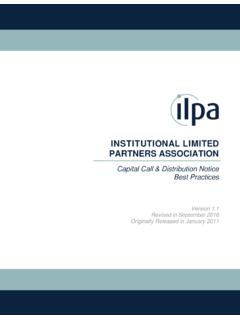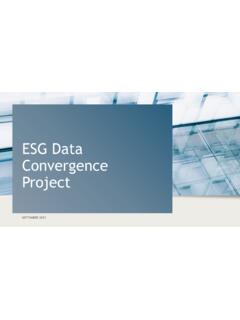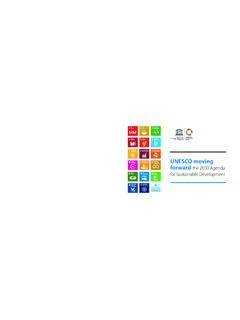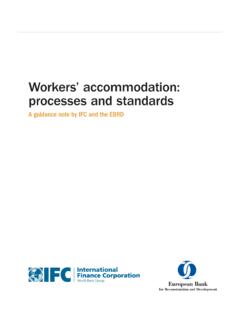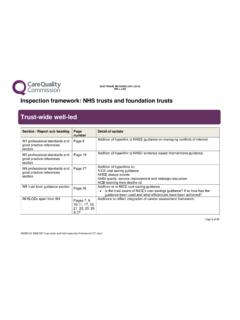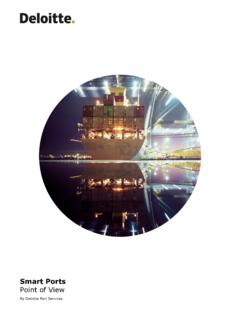Transcription of ESG ASSESSMENT FRAMEWORK
1 1 ILPA ESG ASSESSMENT FrameworkESG ASSESSMENT FRAMEWORKOVERVIEW - HOW TO USE THIS FRAMEWORKILPA released this ESG ASSESSMENT FRAMEWORK as a resource for limited partners looking to build a tool to evaluate and understand the various stages of ESG integration that peers are observing among general partners in the market today. It is designed to help LPs evaluate and benchmark GP responses to due diligence efforts, inform goal-setting conversations with GPs and measure ESG integration progress over time. The FRAMEWORK categorizes activities and processes across four buckets: Not Present, Developing, Intermediate and Advanced. As ESG conversations continue to evolve, many best practices are still being developed. We expect LPs will adapt this FRAMEWORK as appropriate. This FRAMEWORK is meant to be representative but not exhaustive and should not be considered a comprehensive guide to best practice in the FRAMEWORK and FAQ document will be updated on a periodic basis as practices evolve and to address feedback and questions received.
2 We invite all participants in the private equity community to send any feedback or questions to ILPA developed this FRAMEWORK using mid/large cap buyout managers and strategies as its reference point. While the FRAMEWORK may serve as a useful starting point for evaluating managers in other private markets asset classes (venture capital, real estate, infrastructure, private credit, etc.), it was not designed with these asset classes in mind. Smaller managers may not have the resources to land in the Intermediate or Advanced buckets but may take actions which put them at the forefront of their peer group. For this reason, it is important to consider manager size and resources and adjust expectations accordingly. Category/component descriptions are meant to be directional and are not intended to replace or encompass adherence to specific local requirements or regulatory frameworks. The FRAMEWORK may not include or reference every Advanced practice, as these can be subjective and will continue to evolve over time.
3 The FRAMEWORK is not meant to suggest a one-size-fits-all approach but provide a starting point for analysis and dialogues with GPs. Other considerations and frequently asked questions are addressed in our FAQ document, which will be updated on a periodic basis to include and address questions ILPA receives. If your question has not been answered in our FAQ, please contact ILPA at CONSIDERATIONS2 ILPA ESG ASSESSMENT FrameworkESG ASSESSMENT FRAMEWORKCOMPONENTNOT PRESENTDEVELOPINGINTERMEDIATEADVANCEDS tatus of Current PolicyESG policy is lacking or limited; there is no mention of governance and ESG ownership considerations or examples which illustrate a policy in actionPolicy details the GP s approach to identifying and managing ESG factors; reference to basic governance and ownership considerations*Note, pertaining to ESG Policies - LPs should keep in mind that firm level policies may not always apply to specific funds and should ask for clarification where neededPolicy is tailored to the GP s strategy and investable sectors.
4 There is a clear governance structure detailing ESG oversight responsibilities and processes and an approach to identifying material risks and discussing them with portfolio companiesGP is able to provide examples illustrating policy integration efforts in prior fund investmentsBuilding upon Intermediate, policy is shared publicly and references materiality and how ESG considerations drive value creation, including look-forward assessments and commentary tailored to industry segments in which the GP investsGP is able to speak to historical policy revisions, including what changed and whyApproach to Policy ReviewNo policy implemented; no plans to develop an approach towards the management of ESG considerationsGP may reference plans to periodically review or further develop its ESG policy, but detail regarding frequency and timing is lackingGP conducts a periodic review ( every 2-3 years) of its ESG policy and can share recent findings and updatesGP reviews its ESG policy annually and can comment on its evolution (prior findings and how they were addressed, how it keeps pace with industry developments, etc.)
5 Industry Standards and Best PracticesNo commitments to industry standards ( , PRI signatory) or plans to adopt a set of standards in the next few yearsGP has identified a set of standards which it has informally adopted or begun working towards formal adoptionGP is a PRI signatory or has formally adopted at least one set of industry recognized best practicesGP may have multiple, formal commitments to industry standards or best practices and can demonstrate these commitments are integrated into processes, documentation, training and reportingGP actively participates in driving best practice or standard adoption in the industryContractual CommitmentsNo contractual commitments related to ESG made or referenced in fund formation contracts, LPAs or side letters when requested by investorsContractual commitments to ESG appear in side letters and may vary from LP to LPReferences and commitments to ESG are included in private placement memorandums (PPMs) and side lettersCommitments to ESG are referenced in LPAs and tend to include a commitment to annual ESG reportingPOLICIES AND COMMITMENTS TO STANDARDSESG ASSESSMENT FrameworkCOMPONENTNOT PRESENTDEVELOPINGINTERMEDIATEADVANCEDESG OwnershipNo governance/ownership in place for ESG considerationsESG oversight is represented via steering committee or exec level ownership as a shared responsibility ( , part of legal, compliance or investor relations)ESG considerations do not factor prominently in investment committee dialogue or investment decisionsSenior leadership is more actively involved with ESG issues, augmented by dedicated ESG staff or third party experts helping guide the processIndividual(s) charged with ESG oversight sits on investment committees and ESG considerations are included in committee dialogue and investment decisionsLeadership-driven accountability for ESG ownership extends throughout the organization.
6 Including investment and deal team professionals, to ensure ESG considerations are integrated into decision making and operating processes*It is common for larger, advanced GPs to have one or more dedicated ESG resources supporting staff throughout the organizationGOVERNANCEC ontinued next page3 ILPA ESG ASSESSMENT FrameworkCOMPONENTNOT PRESENTDEVELOPINGINTERMEDIATEADVANCEDC apacity Building and TrainingNo training programs focused on ESGAd-hoc ESG training provided for some staff, including new hires responsible for executing some part of the ESG policyThere are more systematic, regular efforts to provide training internally to inform investment teams of ESG best practicesTraining may focus on ESG integration and capacity building, but also should generate awareness around how and when to work with consultants, service providers and field expertsSystematic, regular efforts to provide training for all staff; training includes recognizing ESG-related risks and opportunities specific to the sectors staff coverTraining programs also extend to portfolio companies, providing those boards and leadership teams with industry/sector materiality-based topical trainingGOVERNANCECOMPONENTNOT PRESENTDEVELOPINGINTERMEDIATEADVANCEDA pproach to CommunicationLittle or no coverage of ESG topics at AGMs, LPAC meetings and periodic communications with investorsGP occasionally references ESG at AGMs, LPAC meetings and in its annual reportCoverage of ESG topics appears regularly at AGMs, LPAC meetings, in regular communications with investors and in an annual report which includes case studies and KPIsCommunication/discussion of ESG risks should be proactive and is not limited to incident reporting or problematic situationsBuilding upon Intermediate, communications and discussion of ESG extends beyond risk mitigation and revolves around challenges, recent learnings.
7 Targets/goals and updates on progress, and ties to value creation in the portfolioIncident ReportingNo policy detailing GP s approach to ESG-related incident reporting or evidence exemplifying treatment of prior reported incidents*Note, for all four categories - LPs may have differing definitions for what constitutes an incident; ILPA suggests LPs share and discuss that definition with their GPsGP has a basic approach to ESG-related incident reporting; able to provide limited examples of prior incident communicationsClearly detailed approach to ESG-related incident reporting, GP is able to provide examples of prior communications detailing incidents, resolutions and plans that ensure future incidents are avoidedBuilding upon Intermediate, GP demonstrates a strategic approach to incident remediation and prevention as an organization and can speak to how prior incidents (across funds) have informed its strategyKPIs and ReportingNo ESG KPIs or reporting in place, plans and procedures for collecting future KPIs and managing reporting are not present KPIs may be basic in nature (or a work in progress)
8 And may include yes/no answers to a binary set of questionsReporting is often ad-hoc, or focused on future capacity building objectives and less on material risks and opportunitiesMateriality-based process in place for determining relevant ESG KPIsAnnual reporting includes both qualitative and quantitative updates on ESG considerations, including examples and case studies at the portfolio company levelMateriality-based KPIs remain in constant view as part of an integrated process that includes benchmarking against targetsAnnual reporting includes both qualitative and quantitative updates on ESG considerations, including examples and case studies at the portfolio company level with clear linkages to value creation, and broader, stewardship based objectives and sustainability outcomesCOMMUNICATIONS AND REPORTINGESG ASSESSMENT FrameworkESG ASSESSMENT FRAMEWORK : CONTINUED4 ILPA ESG ASSESSMENT FrameworkCOMPONENTNOT PRESENTDEVELOPINGINTERMEDIATEADVANCEDDue DiligenceESG factors are not a consideration in the investment due diligence processESG diligence is typically conducted by a third-party, focused on compliance-based risks with inclusion in investment committee process on an ad-hoc basisESG diligence is typically a GP-led process (often augmented by third-party experts)
9 Focused on material risksRisks identified during diligence are discussed and factor into investment committee decision makingBuilding upon Intermediate, ESG diligence includes a process for assessing ESG related value creation opportunities utilizing a materiality-based ASSESSMENT FRAMEWORK and encourages significant input from investment, legal and compliance and HR teamsPost-Investment ManagementNo monitoring or management of ESG considerations takes place after an acquisition occursMonitoring and management of ESG considerations is limited and tends to be ad-hoc or reactiveMonitoring and management of ESG considerations occurs as part of a structured process that includes portfolio company onboarding and annual reviews where risks identified during diligence are examined and actions taken to address any findings are discussedMonitoring and management of ESG considerations and KPIs are featured as an ongoing part of the GP s management and value creation processESG assessments are conducted for all portfolio companies on an annual basis.
10 Board members are trained and accountable for material ESG considerationsExit and After SaleNo ESG considerations are incorporated into the exit planning processGP provides ESG related information to buyers upon request or on an ad-hoc basisESG-focused value creation and enhanced risk management considerations feature into investment marketing materials and the data rooms shared with investment bankers and potential buyersBuilding upon Intermediate, GP also formally measures and analyzes the impact of ESG on investment performance and reports on progress at time of exitGP also supports buyers by providing required information and processes to continue any ongoing sustainable investment initiatives at time of saleINVESTMENT PROCESSESG ASSESSMENT FrameworkESG ASSESSMENT FRAMEWORK : CONTINUED5 ILPA ESG ASSESSMENT FrameworkCOMPONENTNOT PRESENTDEVELOPINGINTERMEDIATEADVANCEDP olicies and GovernanceGP does not have a stated DEI Policy, Code of Conduct and Family Leave PolicyGP does not have a governance process in place addressing ownership of DEI considerationsGP has written policies that include a stated DEI Policy, Code of Conduct (addressing sexual harassment and discrimination) and a Family Leave Policy (in jurisdictions where leave is not mandated)Processes addressing DEI priorities have clear ownership, commonly with human resources (and HR alone, or a DEI/ESG specialist).
